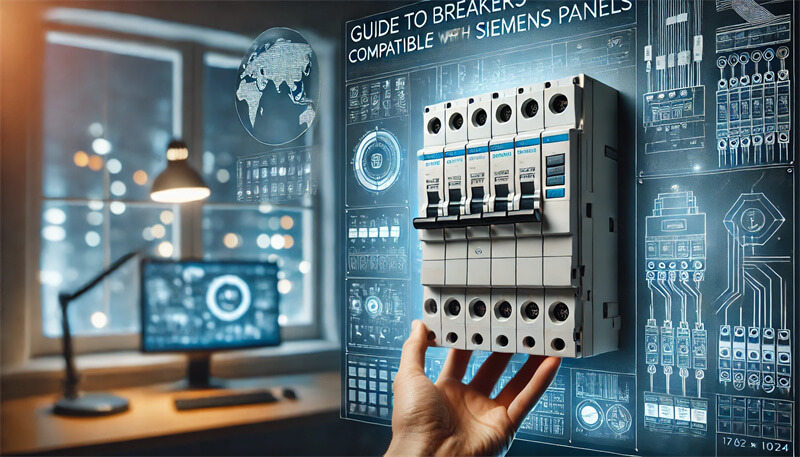Key Takeaways
| Question | Answer |
|---|---|
| What is breaker compatibility? | Breaker compatibility refers to a breaker's ability to fit and function correctly within a particular electrical panel. |
| Which brands are compatible with Siemens breakers? | Murray, Eaton (UL classified), and specific models of Square D. |
| Why is it important to use compatible breakers? | Using compatible breakers ensures safety, reliability, and adherence to electrical standards. |
| What are Siemens QT and QP breakers? | They are specific types of Siemens breakers designed for certain Siemens panels, with unique features and compatibility. |
| Where can I find compatibility information? | Refer to the UL compatibility chart inside your breaker box or consult manufacturer manuals and websites. |
Introduction
Ensuring the compatibility of circuit breakers with your Siemens panels is crucial for maintaining a safe and reliable electrical system. Incompatible breakers can lead to serious safety hazards, including electrical failures and fire risks. This guide will help you understand breaker compatibility and identify which brands and models are suitable for your Siemens panels.
Understanding Circuit Breaker Compatibility
Circuit breaker compatibility means that the breaker not only fits physically but also meets the necessary electrical specifications and safety standards. It’s important to ensure that the breaker you choose can handle the electrical load and functions required by your Siemens panel.
Siemens Circuit Breakers
Siemens is a renowned manufacturer of electrical equipment, known for its high-quality circuit breakers. These breakers are designed to provide reliable protection for electrical systems, and it is generally recommended to use Siemens breakers in Siemens panels to ensure optimal performance and safety.
Types of Siemens Breakers
Siemens QT Breakers:
- Description: Known as "QT Plug-in Circuit Breakers," these are designed for specific Siemens load centers or panels.
- Key Features: Single-pole, double-pole, or triple-pole configurations with various amperages.
- Compatibility: Compatible with Siemens PL, ES, and G series panels.
- Advantages: Easy installation and reliable protection.
Siemens QP Breakers:
- Description: Also known as "QP Plug-in Circuit Breakers," these are widely used in Siemens panels.
- Key Features: Available in single-pole, double-pole, or quad configurations with various amperages.
- Compatibility: Designed for use in Siemens PL, ES, and G series panels.
- Advantages: Solid construction and innovative technology.
Siemens QAF and QPF Breakers:
- Description: Specialized breakers for specific applications.
- Key Features: Enhanced protection features for sensitive circuits.
- Compatibility: Check specific panel requirements.
- Advantages: Additional safety features for specific applications.
Compatible Brands with Siemens Breakers
Murray Breakers
- Compatibility Details: Siemens acquired Murray, and since 2002, Murray breakers have been compatible with Siemens panels.
- Interchangeability: Post-2002 models are interchangeable with Siemens breakers.
Eaton Breakers
- UL Classification: Eaton breakers that are UL-classified can be used as replacements for Siemens breakers.
- Compatibility: Eaton UL classified breakers are designed to meet the compatibility standards required for Siemens panels.
Square D Breakers
- Compatibility Details: Some Square D breakers are compatible with Siemens panels, but it’s crucial to verify model numbers and specifications.
- Important Note: Always check the UL compatibility chart and manufacturer guidelines.
Other Brands
- GE, Cutler-Hammer: These brands may offer compatible breakers, but it’s essential to consult compatibility charts and manufacturer guidelines.
- General Advice: Always refer to the manufacturer’s documentation and consult with a qualified electrician to ensure compatibility and safety.
Safety and Standards
Importance of Using UL Classified Breakers
- Safety Assurance: UL-classified breakers have been tested and certified to meet safety standards.
- Reliability: Using UL classified breakers ensures that your electrical system operates safely and efficiently.
Checking Local Electrical Codes
- Code Compliance: Ensure that the breakers you choose comply with local electrical codes to avoid legal issues and ensure safety.
- Consulting Professionals: It’s advisable to consult with a licensed electrician to verify compliance and installation requirements.
Practical Tips for Ensuring Compatibility
Consulting Compatibility Charts
- How to Use: Compatibility charts are typically found inside the breaker box or on manufacturer websites.
- What to Look For: Ensure the breaker matches the panel’s specifications, including voltage, amperage, and circuit configuration.
Testing Breakers
- Step-by-Step Guide: Before installing, test the breaker to ensure it fits and functions correctly within the panel.
- Visual Inspection: Check for any physical damage or defects.
- Fit Test: Insert the breaker into the panel slot to ensure a proper fit without forcing.
- Functional Test: If possible, use a multimeter to test the breaker's functionality before full installation.
- Professional Testing: For safety, have a professional test the breaker to avoid potential hazards.
Using Official Manuals
- Manufacturer Documentation: Always refer to the manufacturer’s manuals and guidelines for selecting and installing breakers.
- Following Recommendations: Adhering to official recommendations ensures the safety and optimal performance of your electrical system.
Conclusion
Ensuring that you use compatible breakers with your Siemens panels is critical for maintaining a safe and reliable electrical system. Always refer to compatibility charts, use UL classified breakers, and consult with professionals to ensure you make the right choice. The compatibility of your circuit breakers is not just about fitting them into your electrical panel but also ensuring they meet the electrical load and safety standards required.
For more detailed information, visit our Comprehensive Guide to Compatible Breakers for Siemens Panels: Ensuring Safety and Efficiency.
FAQs
What is breaker compatibility?
Breaker compatibility refers to a breaker's ability to fit and function correctly within a particular electrical panel. This means that the breaker must meet the necessary electrical specifications and safety standards.
Which brands are compatible with Siemens breakers?
- Murray: Siemens acquired Murray, and their breakers are compatible with Siemens panels, especially post-2002 models.
- Eaton: UL-classified Eaton breakers can be used as replacements for Siemens breakers.
- Square D: Some Square D breakers are compatible, but it is essential to verify model numbers and specifications.
Why is it important to use compatible breakers?
Using compatible breakers ensures safety, reliability, and adherence to electrical standards. Incompatible breakers can lead to serious safety hazards, including electrical failures and fire risks.
What are Siemens QT and QP breakers?
- Siemens QT Breakers: Known as "QT Plug-in Circuit Breakers," designed for specific Siemens load centers or panels. They are available in single-pole, double-pole, or triple-pole configurations with various amperages.
- Siemens QP Breakers: Also known as "QP Plug-in Circuit Breakers," these are widely used in Siemens panels. They feature solid construction and innovative technology for various electrical systems.
Where can I find compatibility information?
Refer to the UL compatibility chart inside your breaker box or consult manufacturer manuals and websites for reliable compatibility information. It is always advisable to check with a licensed electrician to verify compliance and installation requirements.
For more articles related to Siemens products and comprehensive guides, visit our blog or contact us here.
Related Articles
- Choosing Between Siemens and Delta PLCs
- Understanding Siemens PLC Data Types
- Mastering Siemens PLC Software: A Comprehensive Guide to SIMATIC STEP 7 and TIA Portal
- Safety PLC vs. Normal PLC in Siemens Automation
Explore our wide range of Siemens PLCs, Siemens HMIs, and Siemens Inverters available for all your industrial automation needs.
For any inquiries or further assistance, visit our About page or reach out through our Contact page.
For a more visual and technical guide on configuring your Siemens PLCs and other products, check out these resources:
- Comprehensive Guide to Connecting Your Siemens PLC with an HMI
- How to Create an Array in Siemens PLC
- Ultimate Guide to Buying Siemens PLCs: Top Distributors and Expert Tips
Stay updated with the latest in industrial automation and Siemens products by visiting our Blog.



